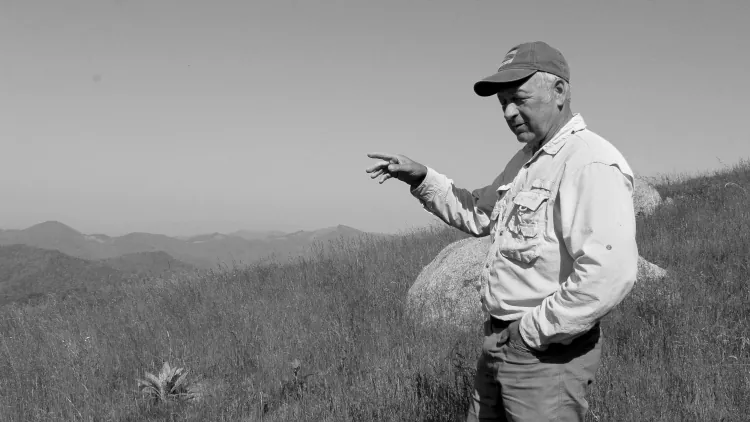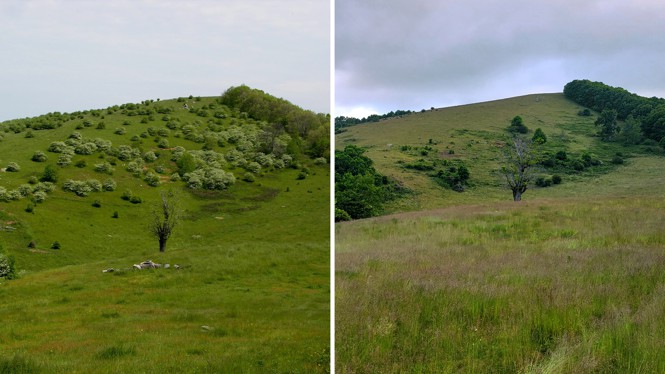Hawthorns Are One of American Botany’s Great Mysteries
These trees once proliferated wildly across eastern North America, but now they’re dying out. Should we let them?

The last time Ron Lance had visited Doggett Gap in western North Carolina, he photographed one of the premier sites for hawthorn trees in the American Southeast. Thousands of white blossoms speckled the hillside, with North Carolina’s Newfound Mountains stretching to the horizon. Last summer, he visited again for the first time in 25 years. All that was left was a field of fescue grass. Only a couple dozen hawthorns remained.
Lance is a caretaker of a nature preserve in North Carolina and an expert on hawthorn trees. (The species Crataegus lancei is named after him.) And for years now, he’s been chronicling their mysterious decline in the eastern half of the United States. A century ago, the trees were all over the eastern landscape. Now finding one anywhere is hard. One Missouri botanist, Justin Thomas, told me they were functionally extinct in his region.
“It’s gotten to the point where I don’t want to see these old places anymore that used to have a lot of hawthorns,” Lance told me. Much of his life’s work is disappearing before his eyes. At the same time, he has made a startling assessment of the former abundance and variation of hawthorns: “I think it might be considered unnatural to begin with,” he told me.
Until the 1890s, hawthorn trees were believed to be a simple taxonomic group, known to science as Crataegus. North America had 10 recognized species. Suddenly, from 1895 to 1910, the number of species exploded, and finding new hawthorns became a competitive sport. In 15 years, a handful of competing “Crataegophiles” identified almost 1,000 new hawthorn species—a rate of species naming that is almost unmatched in biology.
Out of those 1,000, many were the same species being named differently by botanists working independently. But the particular features of the trees themselves could mislead scientists, or at least those inclined to be misled. A 1955 history of hawthorns includes a blind item about a botanist known for his hawthorn obsession, who was once asked by a group of college women to identify three specimens. After he declared them three distinct species based on leaf shape, the women revealed that all three specimens came from the same tree. (The botanist—who was almost certainly Charles S. Sargent, the most prolific namer of hawthorns—reportedly called it a “damned dirty trick.”)
This was what a 1932 article called the “Crataegus problem”—one of the biggest mysteries in American plant taxonomy.
Today, most sources recognize anywhere from 22 to 200 hawthorn species in eastern North America. Whatever the true count, the trees take a vertiginous number of forms in nature. In many cases, one species isn’t intuitively different from another; often, two entities will be identical but for a slightly different leaf shape or a different size fruit. Leigh Van Valen, a prominent evolutionary biologist, wrote in 1976, that perhaps no true hawthorn species exist at all—that they make up a sort of genetic continuum that doesn’t allow for coherent species classification.
Part of the difficulty in identifying hawthorn species is their bizarre reproductive habits. First of all, they hybridize; that is, two species interbreed (as when horses and donkeys beget mules). Second, they are prone to polyploidy, meaning that they may have multiple sets of the same genetic information in their cells. And third, they can clone themselves through seed. In short, hawthorn reproduction can go like this: Two species hybridize and create a polyploid daughter, basically a genetic accident, largely cut off from reproducing sexually with other hawthorns. It can clone itself over and over, until hundreds of trees have spread across a field. They might look and act like a species, but they don’t have the genetic diversity to persist over time. Botanists call these “microspecies.”
This is rare in nature. With highly competitive organisms filling Earth’s habitats, the likelihood that a genetic accident will outcompete them is low. Unless, perhaps, those habitats get shaken up by, say, a couple hundred years of landscape-scale clear-cutting and pasturing by humans and cattle.
This is what Lance means when he says hawthorns’ great diversification may have been unnatural. His hypothesis is this: European colonization remade the eastern North American landscape, converting forests into small cattle farms, logged lands, and fields bordered by sunny hedgerows—prime habitat for hawthorns, which thrive on a forest’s edge. So as settlers cleared land in the 1700s and 1800s, hawthorns proliferated and microspeciated like mad, reaching a critical mass at the end of the 1800s. “They were hybrid inventions of themselves,” Lance said.
Then, those small cattle farms dissolved into massive commercial farms, devoid of hedgerows. Or they reverted to second-growth forests. Hawthorns have been contracting ever since. That, according to Lance, is why botanists can’t find them anymore. Sargent and the early Crataegophiles were seeing an aberration in geologic time.
Not everyone agrees with Lance’s hypothesis. George Yatskievych, a botanist at the University of Texas at Austin, believes hawthorn mania was a reflection of botany itself, which had advanced enough by 1890 to take on complicated plant groups. Speciation doesn’t happen on a dime, he told me. ”You’re looking at hundreds of thousands of years” for speciation to occur in plants, not hundreds.
Tim Dickinson, a hawthorn researcher and emeritus plant curator at the Royal Ontario Museum, thinks hawthorns have evolved in man-made habitats, but pointed out to me that in the past 2.6 million years, glacial advances and retreats would also have opened up habitat for hawthorns. Wesley Knapp, the chief botanist at NatureServe, an organization that assigns rarity scores to plants, agrees with Lance that human influence on the hawthorns’ habitat would have removed obstacles to their reproduction, but he thinks drawing hasty conclusions could lead to hasty extinctions. “If we just dismiss these things as doomed, then we’re probably not going to conserve them,” he told me.
However hawthorns achieved such dizzying diversity, the fact that they’re now disappearing is inarguable. The reasons for that reversal are quite clear, too: Invasive species are choking out forest edges. Second-growth forests are shading hawthorns out. Commercial farms are bulldozing them. A fungal rust is killing them in the Midwest and the South.
“A lot of the so-called species probably will disappear,” Lance told me. Then he added, to my surprise, “Who’s to say that’s a good or a bad thing? It’s just a natural cycle.” But conservationists tasked with trying to save biodiversity have to answer that question. If the present diversity of hawthorns is an artificial result of colonization, do we value the version of nature that preceded European influence, or do we value biodiversity for its own sake? In other words, how hard should we try to save the hawthorns? And which ones?
The question of which hawthorn species are, in fact, species has a practical bearing on these decisions. Alongside North Carolina's Blue Ridge Parkway, for instance, you can find the balsam-mountain hawthorn—a rare species that grows in only one mountain range. A few years ago, conservation groups were gearing up to assign the tree the rarest rank a species can receive, which would imply an urgent necessity to conserve it. But Lance decided it was probably a hybrid of two other hawthorns. He still believed the tree should be protected, but instantly, the species went from critically rare to nonexistent, from a conservation point of view.
With hawthorns suddenly scarce on the landscape, though, parsing out which species are real is next to impossible. “That’s the root of the problem,” Lance said. “They’re gone.”
Arthur Haines, a New England botanist who has studied hawthorns for decades, told me the biggest threat to the trees is not land-use changes but botanists themselves, who are unwilling to meet the taxonomic challenge. If no one takes on the task of categorizing hawthorns, then no conservation group can take any measures to save them. Now that the trees are here, Haines said, “they’re part of our floristic diversity. They came about not because of an arbitrary breeding in greenhouses, but from wild species interacting with each other on the landscape.”
To him, that means they’re worth saving. And every botanist I spoke with agreed with him. A small group of prominent southeastern botanists in North Carolina are now trying to set up an official hawthorn consortium to protect the genus, which would formalize and fund special research and conservation efforts for hawthorns. For most of the 20th century, botanists largely threw up their hands at solving the hawthorn puzzle. Now whatever solution they come to will determine what we try to save.
What's Your Reaction?



















